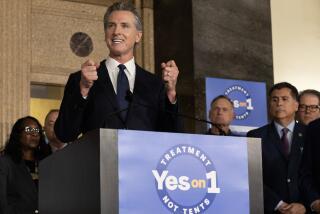Paul Newman Pledges $1 Million to Establish Drug Abuse Center
- Share via
In an effort to create “a special hybrid of professional”--film makers and other media specialists schooled in the latest research on drug abuse prevention--actor Paul Newman announced Monday a pledge of $1.2 million to create a “health communications research” center at USC’s School of Pharmacy.
The money will be channeled through the Scott Newman Foundation, created by Newman after his 28-year-old son, Allan Scott Newman, died of what police termed an accidental overdose of alcohol and Valium in 1978.
Newman’s daughter, Susan Kendall Newman, a 32-year-old producer and director, has worked full time since January developing the Scott Newman Center for Drug Abuse Prevention and Health Communication Research at USC.
Susan Newman said the new center will emphasize the development of television, radio and film productions that help children develop “non-chemical coping skills”--the ability to say no to drugs.
The center will be part of USC’s 5-year-old Health Behavior Research Institute, which has studied substance abuse in children and developed school and television programs aimed at encouraging children to turn down drugs
Paul Newman, speaking with admitted awkwardness in the lights of two dozen newspaper and television cameras at a campus news conference, said he envisions the center as “the largest clearinghouse for films about drug abuse in the country.”
“I don’t know a time in history where it’s so important for the young people to see things with a clarity,” Newman said.
The Newman family foundation has raised $500,000 during the last four years, using those donations and unspecified Newman family contributions to produce anti-drug abuse films and make awards to nationally televised programs dealing with drug abuse.
Blend Fields of Expertise
Newman’s daughter said the actor has provided “seed money” to begin the operation of the Scott Newman Center. She said the foundation’s $1.2-million pledge will be fulfilled over five years, largely through anticipated donations.
Susan Newman said most anti-drug media presentations have failed to offer children ways and rationales for turning down drugs and have not taken full advantage of the type of research conducted at USC’s Health Behavior Research Institute.
The director of the institute, C. Anderson Johnson, said the USC center will attempt to train scientists, health professionals, journalists and film makers to blend their fields of expertise to create more realistic programs.
“We now know that a number of drug abuse prevention programs have not been effective, and in some cases have even encouraged drug use,” Johnson said. “So one of our most important objectives is to determine what types of communications strategies are most effective.”
“You can’t just tell kids who are curious about trying things . . . to just stop doing that,” Susan Newman said. “That natural curiosity has existed since Day 1. You can’t say no without giving options.”
To be credible with young viewers, programs should provide technical information, such as recent findings of the link between marijuana and many of the cancer-promoting agents found in cigarettes, she said.
Programs should “let the audience see what happens when little Jimmy (overdoses and) goes nuts,” and also “let them see what happens when a kid says no,” showing that “he might feel bad socially at first, but he might feel a lot better a couple of days later. . . . You have to show them all the options they have. They may slip once or twice, but most kids want to survive.”
More to Read
Sign up for Essential California
The most important California stories and recommendations in your inbox every morning.
You may occasionally receive promotional content from the Los Angeles Times.










